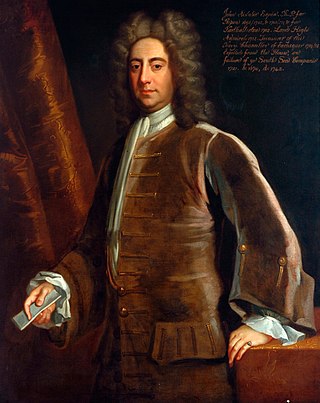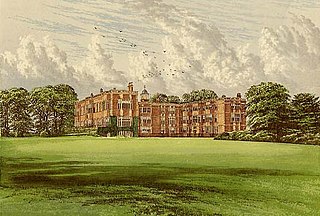Related Research Articles

John Aislabie or Aslabie, of Studley Royal, near Ripon, Yorkshire, was a British politician who sat in the English and British House of Commons from 1695 to 1721. He was of an independent mind, and did not stick regularly to the main parties. He was Chancellor of the Exchequer at the time of the South Sea Bubble and his involvement with the Company led to his resignation and disgrace.

Marquess of Ripon, in the County of York, was a title in the Peerage of the United Kingdom. It was created in 1871 for the Liberal politician George Robinson, 2nd Earl of Ripon.

Studley Royal Park is an estate in North Yorkshire, England. The site has an area of 800 acres (323 ha) and includes an 18th-century landscaped garden; the ruins of Fountains Abbey; Fountains Hall, a Jacobean mansion; and the Victorian St Mary's church, designed by William Burges. Studley Royal House, around which the park and gardens were designed, burned down in 1946. The park, as Studley Royal Park including the ruins of Fountains Abbey, has been designated a World Heritage Site. It has also been designated a grade I listed park and garden by Historic England, and various structures within it are individually listed.
Sir William Hustler, of Acklam, Yorkshire, and Little Hatfield, Holderness, Yorkshire was an English draper and Whig politician who sat in the English and British House of Commons between 1695 and 1710. He was a member of the Society for Promoting Christian Knowledge and was great patron of charity schools.

John Cecil, 6th Earl of Exeter, known as Lord Burleigh from 1678 to 1700, was a British peer and Member of Parliament.

Viscount of Irvine was a title in the Peerage of Scotland. It was created on 23 May 1661 for Henry Ingram, of Temple Newsam, Yorkshire, and Hoar Cross Hall, Staffordshire. He was made Lord Ingram at the same time, also in the Peerage of Scotland.

William Aislabie of Studley Royal, North Yorkshire was an English landowner and Tory politician who sat in the House of Commons for over 60 years from 1721 to 1781. His long unbroken service in the House of Commons was only surpassed, more than 100 years after his death, by the 63 years achieved by Charles Pelham Villiers at Wolverhampton.

Sir Arthur Ingram was an English investor, landowner and politician who sat in the House of Commons at various times between 1610 and 1642. The subject of an influential biography, he has been celebrated for his "financial skill and ruthless self-interest", and characterized as "a rapacious, plausible swindler who ruined many during a long and successful criminal career". Probably of London birth but of Yorkshire background, he was a very extensive landowner in Yorkshire. He acquired and rebuilt the former Lennox residence at Temple Newsam near Leeds, which became the principal seat of his family, including the Lords Ingram, Viscount Irvine and their descendants, for over 300 years.
Arthur Ingram, 3rd Viscount of Irvine was an English Member of Parliament and peer. He was the Vice-Admiral of Yorkshire and Member of Parliament for Yorkshire and Scarborough. He was the father or grandfather of all the later Viscounts Irvine.

Charles Ingram, 9th Viscount of Irvine, known as Charles Ingram until 1763, was a British landowner, politician and courtier. He succeeded his uncle to the Viscountcy and the Temple Newsam estate in Leeds in 1763.

William Mallory of Studley Royal, Yorkshire was an English politician who sat in the House of Commons variously between 1614 and 1642. He supported the Royalist side in the English Civil War. His father, John Mallory, was also an MP of Ripon.
Colonel Rich Ingram, 5th Viscount of Irvine, was an English peer and politician.
Arthur Ingram, 6th Viscount of Irvine, styled the Honourable Arthur Ingram until 1721, was a British landowner and politician who sat in the House of Commons from 1715 until 1721 when he succeeded to the peerage as Viscount Irvine.

Henry Ingram, 7th Viscount of Irvine, styled The Honourable Henry Ingram until 1736, was an English landowner and politician.
Colonel the Honourable Charles Ingram, was a British soldier and politician.
John Machell (1637–1704) was for twenty years Member of Parliament for Horsham, Sussex, during the reigns of Charles II, James II and William III and Mary II. By the marriage of his daughter Isabella Machell (1670–1764) to Arthur Ingram, 3rd Viscount of Irvine, he became the grandfather of the fourth, fifth, sixth, seventh and eighth Viscounts of Irvine, and great-grandfather of the ninth, seated at Temple Newsam near Leeds, whose family inherited and augmented his valuable property of Hills house at Horsham, and continued the parliamentary tradition there.
George Ingram, 8th Viscount Irvine (1694-1763) was an English clergyman and peer in the Peerage of Scotland. His occupation of the Viscountcy was brief, from 1761 to 1763. He was Chaplain to the Speaker of the House of Commons.

Robert Tennant of Chapel House in the parish of Conistone, Yorkshire, England, was the Conservative Party Member of Parliament for Leeds, Yorkshire, from 1874 to 1880. He served as a captain in the Yorkshire Hussars and as a Justice of the Peace for Yorkshire and for Ross and Cromarty and Sutherland in Scotland.

Charles Eversfield of Denne Place, near Horsham, Sussex, was a British Tory politician who sat in the House of Commons between 1705 and 1747.
Sir John Lyster Kaye, 4th Baronet (1697–1752) of Denby Grange, Kirkheaton, Yorkshire, was a British landowner and Tory politician who sat in the House of Commons from 1734 to 1741.
References
- ↑ "item WARE/1/2/7 - Lease and release". University of York .
- ↑ "SE428892 (OS grid reference)". geograph.org.uk.
- ↑ The Tourist's Guide; Being a Concise History and Description of Ripon, etc. Ripon: John Lewis Linney. 1837. p. 75.
- ↑ "INGRAM, Arthur (d.1742), of Borrowby, Yorks." from: Sedgwick, R., ed. The History of Parliament: the House of Commons 1715-1754, 1970. in historyofparliamentonline.org accessed 31 August 2021